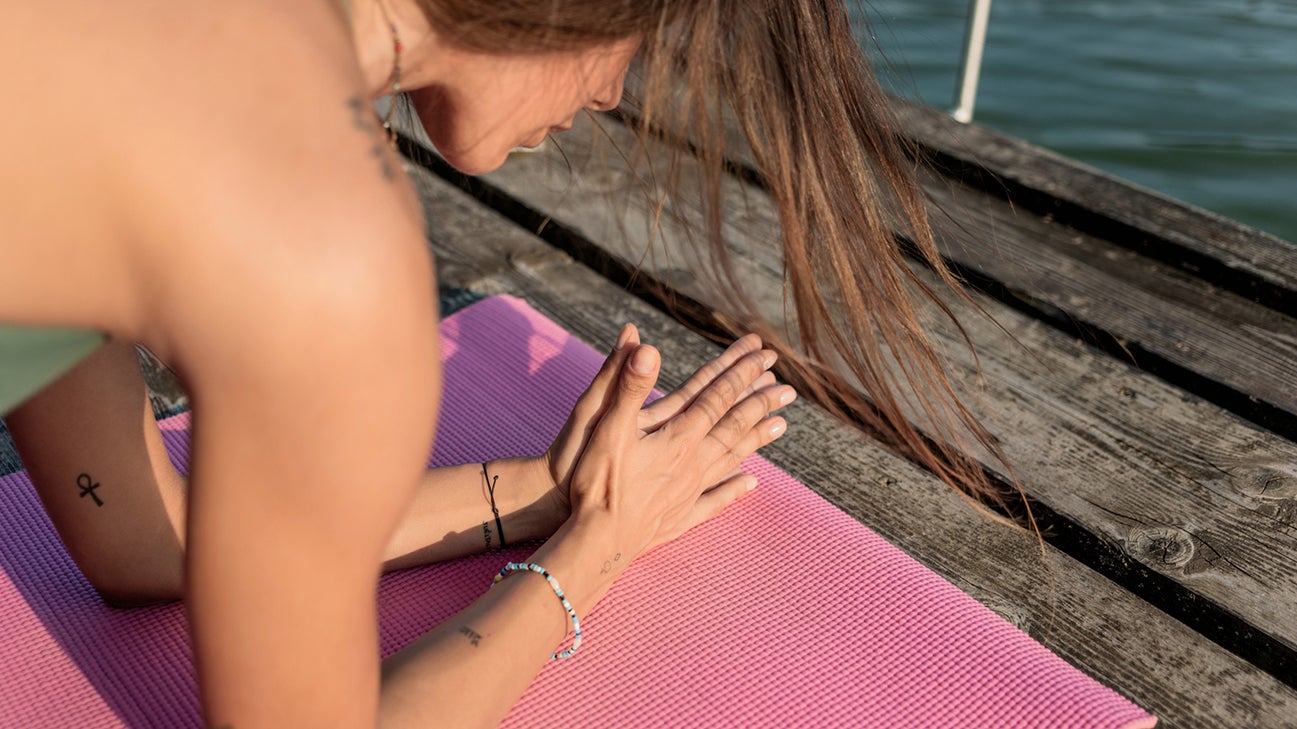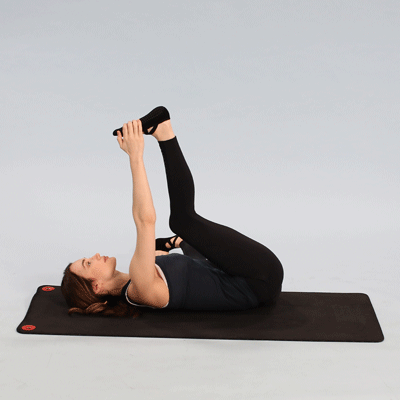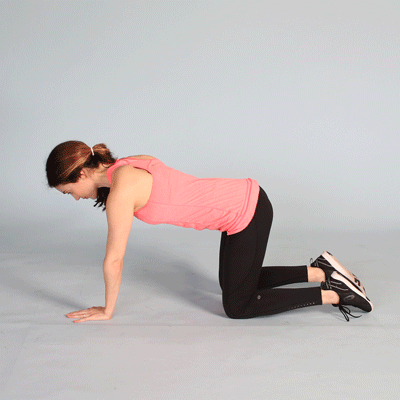Everyone’s yoga journey is different — we’re all improving different things in our own ways. But core strength and mobility are timeless classics. Who doesn’t want to beat backaches and straighten up that chair-bound posture? Frog Pose helps intermediate to advanced yogis do exactly that. Let’s learn more.
What is Frog Pose, and how can it improve your life?
Prepare for the fastest, most convenient rundown of a yoga pose you’ve ever experienced. Kapow! Here it comes:
- Frog Pose is a yoga pose that’s also known as Mandukasana in Sanskrit.
- It’s an intermediate- to expert-level position. Frog is hard.
- It’s a “hip opener,” which means it can help you develop mobility in your hips and inner thighs.
- It’s also good for core strength.
- You might not be able to pull it off right away, but modifications can help you prepare.
Let’s hop to it.

How to get into Frog Pose
Be careful, because this is an advanced pose. if you’re attempting it for the first time, you might want to use a mat or blanket to take some pressure off your knees.
Here’s how to do Frog Pose in yoga:
- Start on your hands and knees. Your hands should be aligned beneath your shoulders, and your knees beneath your hips.
- Inhale. Then, as you exhale, begin to push your knees out to the sides.
- When you begin to feel the stretch on your inner thighs and groin, stop pushing and inhale again before you continue pushing. Don’t strain your body beyond what it can comfortably achieve.
- Turn your feet sideways, so you’re resting on your inner feet, ankles, and thighs.
- Lower down onto your forearms, with your palms flat against the floor.
- Hold yourself here for 5–10 breaths.
- To get out of Frog Pose, raise back up onto your hands, and then walk your knees back together.
If it hurts, go easy on those froggy legs
Yoga shouldn’t hurt. If you start to feel excess strain or pressure, ease up. You might need to warm up a little more or try one of the less challenging positions below to build confidence.
Your breath is a good indicator of whether you’re straining yourself too much. If you can’t take deep, cleansing breaths, ease up until you can breathe comfortably again.
What are the benefits of Frog Pose in Kundalini yoga?
Frog Pose is meant to open up your hips and groin, increasing their flexibility. It targets the muscles in your inner thighs, called your adductors, and also benefits your core strength.
If you spend long hours sitting at a desk or driving, working on these areas can do wonders for back pain or muscle tightness in your hips. Over time, you’ll find your lower body becoming stronger and more mobile.
It’s no surprise that more and more people are embracing the benefits of yoga. Our increasingly sedentary lifestyles are risk factors for a number of health issues, including:
- less efficient glucose, fat, and carb metabolism
- reduced heart output and blood circulation
- lower insulin resistance (meaning your bloodstream hangs on to more glucose, which… isn’t great for your risk of diabetes)
- a higher risk of cancer and heart disease
Yoga can get you moving, boost your body’s defenses against these imbalances, promote positive health behaviors, and reduce stress and obesity risk.
The stress factor is hugely important. Yoga not only tackles the physical impact of spending too much time sitting on your booty but also promotes a sense of well-being and improved mental health.
Frog Pose will appear on your lily pad (erm, yoga mat) quite some way into your yoga journey. This means that by the time you have the ability to pull it off, you’ll already be knee-deep in yoga benefits.
What is Kundalini yoga?
Sometimes given the moniker “the yoga of awareness,” Kundalini yoga is about more than just physically stretching your body.
It can involve:
- chanting
- breathing exercises
- singing
- repetitive poses
This is yoga for those who want to dive a little deeper (not unlike a frog) into their spiritual side. This type of yoga aims to help you get in touch with your Kundalini energy, or shakti — spiritual energy that yoga tradition believes emerges from the bottom of your spine.
Not all types of yoga are everyone’s cup of tea, so find the one that works best for you.
Try these Frog Pose variations to prepare your hips
Frog Pose isn’t easy. Within the Kundalini yoga canon, it’s viewed as a pose for those with a bit of training under their belts. Developing your core strength, as well as your hip and thigh mobility, is key to unlocking success with the pose.
Here, we’ve broken down some alternatives and modifications of Frog Pose that will ease you in. Use these to build confidence — they’re your springboard to bigger and better things.
Happy Baby Pose

This beginner-friendly yoga pose doesn’t only boast an adorable name, it also targets those inner thighs. Building up your thigh strength is essential for a proper Frog Pose.
- Lie flat on your back.
- Pull your knees up to your chest.
- Grip the outsides of your feet to stabilize yourself.
- Open up your knees until they’re wider than your torso. Get them as wide as they can comfortably go.
- Press the sides of your feet into your hands to add resistance.
- Focus on your breathing and hold for 5–10 breaths.
Get your tadpole on!
Thread the Needle

Here’s another beginner-friendly pose that can help open up those hips, loosen your lower back, and stretch those inner thighs while you work your way up to Frog.
Try the following:
- Start on all fours. Make sure your hands are aligned with your shoulders, pointing toward the top of the mat, and your hips line up with your knees. Inhale.
- As you exhale, gently slide your right arm through the gap between your left arm and hip. Allow your right shoulder to drop to the mat, with your right arm extended as far as feels comfortable.
- Turn your head to the left, placing your right ear and cheek on the mat. Placing weight on your head risks neck and shoulder injury, so be sure to balance your weight and find a comfortable spread of pressure on your right shoulder.
- Keep your left elbow elevated a little, and make sure your hips are lifted for maximum stretch.
- Widen your upper back, taking any pressure off your lower back. Take a second to breathe out the tension in your neck, arms, and shoulders.
- You can hold this pose for up to a minute, or however long feels comfortable.
- Exit the pose by sliding your right arm back out from under your left arm. Put some gentle pressure in your left arm to leave some arm-releasing space. Move your right arm back to where it started in step 1 to return to an all-fours position.
- Repeat the pose on the other side, making sure you spend the same amount of time on each side — spread the love.
Reclined Bound Angle Pose
Let’s step things up. Reclined Bound Angle isn’t a move for total beginners, but it’s not quite as demanding on your knees and thighs as Frog Pose. Still, it’s best to take the same precautions and avoid straining your body beyond its limits.
Try it like this:
- Lie faceup with knees bent and feet flat on the floor.
- Take a deep breath and slide the soles of your feet inward until they come together.
- Let your knees fall out to the sides, as far as they can go without straining.
- Put your right hand on your heart and your left hand on your stomach.
- Hold for 5–10 breaths.
Half Frog Pose
You’re nearly there! Half Frog is the bridge between the other modifications and full Frog (#FrogGoals).
It has many of the same benefits but also comes with the same cautions: Make sure you’re warmed up, and take it easy if things start to hurt.
Here’s how to do Half Frog Pose the right way:
- Lie facedown and align your elbows under your shoulders, with your forearms pointing forward.
- Draw your shoulders back, extending your chest.
- Squeeze your inner thighs together and engage those glutes.
- Bend your left leg, bringing the heel up as close to your butt as you can.
- With your left hand, reach back and grip the top of your left foot.
- Once your left heel is as close to your butt as you can comfortably get it, align your left elbow above your left foot so it’s pointing up.
- Hold for 5–10 breaths.
- Return to the starting position and repeat with the other leg.
If you feel like adding some extra burn, straighten your supporting arm during step 6 so your torso lifts up.
Avoid these Frog Pose mistakes and improve your form
As you might expect from a more advanced yoga position, Frog Pose has a few surprises in store for the unprepared. Focus on dodging these common yoga errors and streamline your journey.
Don’t forget to breathe
Spoiler: Breathing is pretty important – especially in yoga.
As the stretch gets deeper, it’s tempting to focus on your form over breath control. But yoga is all about the union of breathing and motion, so you need to pay attention to both. If you start to feel pain, ease up on the stretch, not your breath.
Avoid forcing your knees
If you’re feeling the stretch, you’re benefiting from the exercise. It’s not a race to match the perfect form shown by yoga teachers who have been working at it for decades. If that stretch turns into pain, ease up.
Keep your back flat
A strong core and a flat back are essential to Frog Pose. Make sure you’re feeling the effects in your core, hips, and thighs. Dipping your lower back will make the move easier but also cheat you out of some of the pose’s beneficial effects.
Is Frog Pose safe?
Like any advanced physical activity, particularly where yoga is concerned, Frog Pose is as safe as you make it. Trying to tackle perfect form before your hips, thighs, and core are ready risks stress and injury.
Likewise, if you’re using yoga to rehabilitate an injury, consider how advanced you want to get.
By the time you’re ready to add this pose to your regular yoga flows, you should have a good understanding of your body. Yoga is ideal for getting that insight. You’ll know better than anyone else what you’re capable of trying safely.
Conclusion: A challenging pose with legs
Getting the hang of Frog Pose is a sure sign that your yoga journey is progressing well. It puts pressure on key areas of mobility, and it doesn’t kid around.
Modifications like Half Frog and Happy Baby (awwww) can help you ease into this yogi-tier pose. With any advanced pose, it’s important to always have an inner eye turned to your breathing — lose that and you lose the very essence of yoga.
The benefits are huge (as long as you know your limits), and yoga is all about developing that self-awareness and confidence.

0 Commentaires